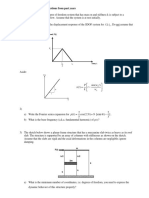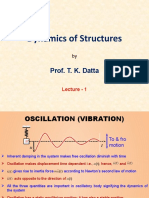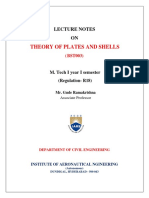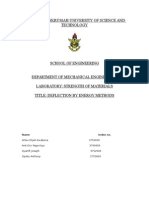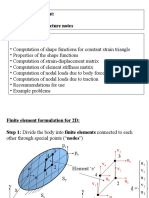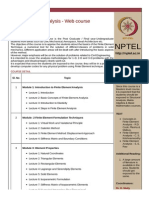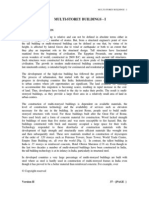0 ratings0% found this document useful (0 votes)
313 viewsIntroduction To Earthquake Engineering
The NPTEL syllabus provides an outline for an introductory course on earthquake engineering. The course covers fundamental concepts of seismology, earthquake inputs like response spectra, structural dynamics for earthquake analysis, response analysis using time history and response spectrum methods, soil-structure interaction, inelastic response of structures, and base isolation design. It includes 7-8 hours of instruction on each topic, with examples and tutorial problems to illustrate key concepts. The course aims to provide undergraduate and post-graduate students, as well as practitioners, with useful knowledge of analyzing and designing structures for earthquake resistance.
Uploaded by
Ajay AjaiCopyright
© © All Rights Reserved
Available Formats
Download as PDF, TXT or read online on Scribd
0 ratings0% found this document useful (0 votes)
313 viewsIntroduction To Earthquake Engineering
The NPTEL syllabus provides an outline for an introductory course on earthquake engineering. The course covers fundamental concepts of seismology, earthquake inputs like response spectra, structural dynamics for earthquake analysis, response analysis using time history and response spectrum methods, soil-structure interaction, inelastic response of structures, and base isolation design. It includes 7-8 hours of instruction on each topic, with examples and tutorial problems to illustrate key concepts. The course aims to provide undergraduate and post-graduate students, as well as practitioners, with useful knowledge of analyzing and designing structures for earthquake resistance.
Uploaded by
Ajay AjaiCopyright
© © All Rights Reserved
Available Formats
Download as PDF, TXT or read online on Scribd
You are on page 1/ 4
NPTEL Syllabus
Introduction to Earthquake Engineering -
Web course
COURSE OUTLINE
The course on Introduction to Earthquake Engineering provides the fundamental
concepts, principles and application of earthquake engineering in seismic
analysis and design of structures.
The course begins with the Seismology explaining the causes of occurrence of
earthquake and its characterization. The seismic analysis of the structures under
earthquake excitation is developed. The structural system modeled as discrete
and continuous system.
The concept of response spectrum analysis procedure to determine structure
response and design earthquake forces is explained. The codal provisions for
earthquake resistant design of structures as per Indian Standards are explained.
Fi nal l y, t h e course also covers the soil structure interaction and inelastic
response spectra. The advanced course material on Earthquake Engineering
will be very useful to undergraduate students, post-graduate students, teachers
and practitioners.
A number of chosen problems will be solved to illustrate the design and analysis
concepts clearly.
COURSE DETAIL
Sl.No. Topic No. of Hours
1. Seismology:
Earth's Interior and Plate Tectonics;
Causes of Earthquakes and Seismic Waves;
Measurement of Earthquakes and
Measurement parameters;
Modification of Earthquake due to the Nature
of Soil;
Seismic Hazard Analysis I;
Seismic Hazard Analysis II; Discussion on
Tutorial Problems.
7
2. Earthquake Inputs:
Time History Records and Frequency
Contents of Ground Motion;
Power Spectral Density Function of Ground
Motion; Concept of Response Spectrums of
Earthquake;
Combined DVA Spectrum and
Construction of Design Spectrum; Site
Specific, Probabilistic and Uniform Hazard
Spectrums;
7
NPTEL
http://nptel.iitm.ac.in
Civil Engineering
Pre-requisites:
Structural Dynamics.
Additional Reading:
1. Journals Related to Earthquake
Engineering and Bureau of
Indian Standard codes.
Coordinators:
Dr. R.S. Jangid
Department of Civil EngineeringIIT
Bombay
Predictive Relationships for earthquake
parameters;
Discussion on Tutorial Problems.
3. Dynamics for Earthquake Analysis:
Equations of Motion for SDOF and MDOF
Systems; Undamped Free Vibration of
SDOF and MDOF Systems;
Mode Shapes and Frequencies of MDOF
System; Rayleigh Damping Matrix;
Direct Time Domain Analysis of MDOF
System;
Direct Frequency Domain Analysis of MDOF
System;
Modal Analysis in Time and Frequency
Domain;
Discussion on Tutorial Problems.
7
4. Response Analysis for Specific Ground
Motion:
Equations of Motion for Single and Multi
Support Excitations and Solutions;
Equations of Motion in State Space and
Solutions;
Computational Steps for the Solutions using
MATLAB I;
Computational Steps for the Solutions using
MATLAB II;
Time History Analysis of 3D Tall Buildings;
Discussion on Tutorial Problems.
6
5. Response Spectrum Method of Analysis:
Concept of Equivalent Lateral Force for
Earthquake;
Modal Combination Rules;
Response Spectrum Method of Analysis of
Structures and Codal Provisions;
Response Spectrum Method of Analysis for
Torsionally Coupled Systems;
Response Spectrum Method of Analysis for
NonClassically Damped Systems;
Discussion on Tutorial Problems.
6
6. Seismic Soil - Structure Interaction:
Fundamentals of Seismic SoilStructure
Interaction;
Direct Method of Analysis of SoilStructure
6
Interaction using FEM and Use of ABAQUS
Software I;
Direct Method of Analysis of SoilStructure
Interaction using FEM and Use of ABAQUS
Software II;
Substructuring Method of Analysis of Soil
Structure Interaction Problem I;
Substructuring Method of Analysis of Soil
Structure Interaction Problem II;
Discussion on Tutorial Problems.
7. Inelastic Response of Structures for
Earthquake Forces:
Fundamental Concepts of Inelastic
Response Analysis for Earthquake Forces;
Solutions of Incremental Equations of
Motions for SDOF Systems;
Solutions of Incremental Equations of
Motions for MDOF Systems;
Push over Analysis;
Concepts of Ductility and Inelastic Spectrum;
Discussion on Tutorial Problems.
6
8. Base isolation for earthquake resistant design
of structures:
Base isolation concept, isolation systems
and their modeling;
linear theory of base isolation;
stability of elastomeric bearings;
codal provisions for seismic isolation,
practical applications.
6
References:
1. Clough R.W. and Penzien J., 'Dynamics of Structures', McGraw-Hill, 2nd
edition, 1992.
2. Newmark N.M. and Rosenblueth E., 'Fundamentals of Earthquake Engg.,'
Prentice Hall, 1971.
3. David Key, 'Earthquake Design Practice for Buildings', Thomas Telford,
London, 1988.
4. Ellis L. Krinitzsky, J.M. Gould and Peter H. Edinger, 'Fundamentals of
Earthquake Resistant Construction', John Wiley, 1993.
5. Blume J.A., Newmark N.M., Corning L.H., 'Design of Multi-storied
Buildings for Earthquake ground motions', Portland Cement Association,
Chicago, 1961.
6. Pankaj Agarwal and Manish Shrikhande, 'Earthquake Resistant Design of
Structures', PHI, 2008.
7. Proc. of World Conferences on Earthquake Engg., 1956-2008.
8. I.S. Codes No. 1893, 4326, 13920 etc.
A joint venture by IISc and IITs, funded by MHRD, Govt of India http://nptel.iitm.ac.in
You might also like
- IDARC 2D Version 4.0 A Program For The Inelastic Damage Analysis of BuildingsNo ratings yetIDARC 2D Version 4.0 A Program For The Inelastic Damage Analysis of Buildings206 pages
- Structural Dynamics and Earthquake EngineeringNo ratings yetStructural Dynamics and Earthquake Engineering72 pages
- Presentation # 1 CE 527 - Earthquake EngineeringNo ratings yetPresentation # 1 CE 527 - Earthquake Engineering61 pages
- CE490 F21 Chapter 6 Analysis ProceduresNo ratings yetCE490 F21 Chapter 6 Analysis Procedures47 pages
- Opensees-Snopt: Framework For Finite Element Based OptimizationNo ratings yetOpensees-Snopt: Framework For Finite Element Based Optimization68 pages
- Finite Element Method in Structure Ass-ALENo ratings yetFinite Element Method in Structure Ass-ALE19 pages
- Structural Steel Design Course Plan - 2015 PDFNo ratings yetStructural Steel Design Course Plan - 2015 PDF7 pages
- Seismic Vulnerability Evaluation of Existing R.C. Buildings: HBRC JournalNo ratings yetSeismic Vulnerability Evaluation of Existing R.C. Buildings: HBRC Journal9 pages
- 14.beam Analysis Using The Stiffness MethodNo ratings yet14.beam Analysis Using The Stiffness Method23 pages
- Dynamics of Structures: Prof. T. K. DattaNo ratings yetDynamics of Structures: Prof. T. K. Datta12 pages
- CE-658 Earthquake Engineering: Elastic Response Spectra Submitted by Alban KURIQI100% (1)CE-658 Earthquake Engineering: Elastic Response Spectra Submitted by Alban KURIQI35 pages
- RC Frame Building With Masonry Infill Walls Designed For Gravity LoadsNo ratings yetRC Frame Building With Masonry Infill Walls Designed For Gravity Loads16 pages
- Specialized 413a - Course-Syllabus-OBE-CDIO-Format-2022No ratings yetSpecialized 413a - Course-Syllabus-OBE-CDIO-Format-20228 pages
- Linear Procedures in Seismic Performance Analysis of DifferentNo ratings yetLinear Procedures in Seismic Performance Analysis of Different11 pages
- Introduction To Physics - Lecture 01 - Measurement - Alpha SeriiesNo ratings yetIntroduction To Physics - Lecture 01 - Measurement - Alpha Seriies12 pages
- Design of Thi and Gant:) ' Structure Requi Es B Sic of Both Sta Ics and Dynamics. WH CH The Subject Engineering Mechanil::SNo ratings yetDesign of Thi and Gant:) ' Structure Requi Es B Sic of Both Sta Ics and Dynamics. WH CH The Subject Engineering Mechanil::S3 pages
- Part 5 - Linear Regression and Curve Fitting CH. 17, 18No ratings yetPart 5 - Linear Regression and Curve Fitting CH. 17, 1868 pages
- Engineering Structures: Phaiboon PanyakapoNo ratings yetEngineering Structures: Phaiboon Panyakapo14 pages
- Reading Assignment: Logan 6.2-6.5 + Lecture Notes SummaryNo ratings yetReading Assignment: Logan 6.2-6.5 + Lecture Notes Summary32 pages
- 13 Base Isolation For Earthquake ResistanceNo ratings yet13 Base Isolation For Earthquake Resistance9 pages
- A Catalogue of Details on Pre-Contract Schedules: Surgical Eye Centre of Excellence - KathFrom EverandA Catalogue of Details on Pre-Contract Schedules: Surgical Eye Centre of Excellence - KathNo ratings yet
- Structural Engineering DocumentsFrom EverandStructural Engineering DocumentsJorge de BritoNo ratings yet
- Silver Oak University: Engineering and Technology (M.Tech.)No ratings yetSilver Oak University: Engineering and Technology (M.Tech.)4 pages
- Assessing Seismic Resilience in Suspension Bridges: Nonlinear Modeling and Strategies for Mitigating FailuresFrom EverandAssessing Seismic Resilience in Suspension Bridges: Nonlinear Modeling and Strategies for Mitigating FailuresNo ratings yet
- M. Tech. (Structural Engineering) SCHEME OF EXAMINATIONNo ratings yetM. Tech. (Structural Engineering) SCHEME OF EXAMINATION26 pages
- Short Time Response Spectrum Ground Motion AnalysisNo ratings yetShort Time Response Spectrum Ground Motion Analysis56 pages
- Is 1893 2016 & 2023 Response Spectrum Z3, Z4, Z5No ratings yetIs 1893 2016 & 2023 Response Spectrum Z3, Z4, Z521 pages
- Development of A New Family of Normalized Modulus Reduction and Materials Dumping Curves Darendeli PhD-2008)No ratings yetDevelopment of A New Family of Normalized Modulus Reduction and Materials Dumping Curves Darendeli PhD-2008)25 pages
- Standard Practice For The Design and Construction of Reinforced Concrete Chimneys (ACI 307-95)No ratings yetStandard Practice For The Design and Construction of Reinforced Concrete Chimneys (ACI 307-95)16 pages
- Advanced Analysis of Cable Stayed Bridges For Extreme EventsNo ratings yetAdvanced Analysis of Cable Stayed Bridges For Extreme Events20 pages
- c2TR Version 5.10 CAESAR II Technical Reference Manual100% (1)c2TR Version 5.10 CAESAR II Technical Reference Manual634 pages
- Site Response Analysis (SRA) : A Practical Comparison Among Different Dimensional ApproachesNo ratings yetSite Response Analysis (SRA) : A Practical Comparison Among Different Dimensional Approaches8 pages
- Pushover Analysis of Jacket Structure in Offshore Platform Subjected To Earthquake With 800 Years Return PeriodNo ratings yetPushover Analysis of Jacket Structure in Offshore Platform Subjected To Earthquake With 800 Years Return Period10 pages
- Adapting The Structural Design Actions Standard For The Seismic Design of New Industrial PlantNo ratings yetAdapting The Structural Design Actions Standard For The Seismic Design of New Industrial Plant8 pages
- Design Basis FOR Earthquake: Rev. Date Description Prpd. Chkd. AppdNo ratings yetDesign Basis FOR Earthquake: Rev. Date Description Prpd. Chkd. Appd9 pages
- Engineering Reports - 2020 - Ferreira - An Artificial Accelerogram Generator Code Written in MatlabNo ratings yetEngineering Reports - 2020 - Ferreira - An Artificial Accelerogram Generator Code Written in Matlab17 pages
- Bridge Foundations, Modeling Large Pile Groups - Po Lam, H.law and R. Martin100% (2)Bridge Foundations, Modeling Large Pile Groups - Po Lam, H.law and R. Martin148 pages
- Comparative Study On Dynamic Analysis of Irregular Building With Shear WallsNo ratings yetComparative Study On Dynamic Analysis of Irregular Building With Shear Walls9 pages
- Base Isolated Building Design Based On ASCE 7-16/10 Design CriteriaNo ratings yetBase Isolated Building Design Based On ASCE 7-16/10 Design Criteria3 pages
- Seismic Response of RC Structures Subjected To Simulated GroundNo ratings yetSeismic Response of RC Structures Subjected To Simulated Ground18 pages
- IDARC 2D Version 4.0 A Program For The Inelastic Damage Analysis of BuildingsIDARC 2D Version 4.0 A Program For The Inelastic Damage Analysis of Buildings
- Opensees-Snopt: Framework For Finite Element Based OptimizationOpensees-Snopt: Framework For Finite Element Based Optimization
- Seismic Vulnerability Evaluation of Existing R.C. Buildings: HBRC JournalSeismic Vulnerability Evaluation of Existing R.C. Buildings: HBRC Journal
- CE-658 Earthquake Engineering: Elastic Response Spectra Submitted by Alban KURIQICE-658 Earthquake Engineering: Elastic Response Spectra Submitted by Alban KURIQI
- RC Frame Building With Masonry Infill Walls Designed For Gravity LoadsRC Frame Building With Masonry Infill Walls Designed For Gravity Loads
- Specialized 413a - Course-Syllabus-OBE-CDIO-Format-2022Specialized 413a - Course-Syllabus-OBE-CDIO-Format-2022
- Linear Procedures in Seismic Performance Analysis of DifferentLinear Procedures in Seismic Performance Analysis of Different
- Introduction To Physics - Lecture 01 - Measurement - Alpha SeriiesIntroduction To Physics - Lecture 01 - Measurement - Alpha Seriies
- Design of Thi and Gant:) ' Structure Requi Es B Sic of Both Sta Ics and Dynamics. WH CH The Subject Engineering Mechanil::SDesign of Thi and Gant:) ' Structure Requi Es B Sic of Both Sta Ics and Dynamics. WH CH The Subject Engineering Mechanil::S
- Part 5 - Linear Regression and Curve Fitting CH. 17, 18Part 5 - Linear Regression and Curve Fitting CH. 17, 18
- Reading Assignment: Logan 6.2-6.5 + Lecture Notes SummaryReading Assignment: Logan 6.2-6.5 + Lecture Notes Summary
- A Catalogue of Details on Pre-Contract Schedules: Surgical Eye Centre of Excellence - KathFrom EverandA Catalogue of Details on Pre-Contract Schedules: Surgical Eye Centre of Excellence - Kath
- Silver Oak University: Engineering and Technology (M.Tech.)Silver Oak University: Engineering and Technology (M.Tech.)
- Assessing Seismic Resilience in Suspension Bridges: Nonlinear Modeling and Strategies for Mitigating FailuresFrom EverandAssessing Seismic Resilience in Suspension Bridges: Nonlinear Modeling and Strategies for Mitigating Failures
- M. Tech. (Structural Engineering) SCHEME OF EXAMINATIONM. Tech. (Structural Engineering) SCHEME OF EXAMINATION
- Short Time Response Spectrum Ground Motion AnalysisShort Time Response Spectrum Ground Motion Analysis
- Development of A New Family of Normalized Modulus Reduction and Materials Dumping Curves Darendeli PhD-2008)Development of A New Family of Normalized Modulus Reduction and Materials Dumping Curves Darendeli PhD-2008)
- Standard Practice For The Design and Construction of Reinforced Concrete Chimneys (ACI 307-95)Standard Practice For The Design and Construction of Reinforced Concrete Chimneys (ACI 307-95)
- Advanced Analysis of Cable Stayed Bridges For Extreme EventsAdvanced Analysis of Cable Stayed Bridges For Extreme Events
- c2TR Version 5.10 CAESAR II Technical Reference Manualc2TR Version 5.10 CAESAR II Technical Reference Manual
- Site Response Analysis (SRA) : A Practical Comparison Among Different Dimensional ApproachesSite Response Analysis (SRA) : A Practical Comparison Among Different Dimensional Approaches
- Pushover Analysis of Jacket Structure in Offshore Platform Subjected To Earthquake With 800 Years Return PeriodPushover Analysis of Jacket Structure in Offshore Platform Subjected To Earthquake With 800 Years Return Period
- Adapting The Structural Design Actions Standard For The Seismic Design of New Industrial PlantAdapting The Structural Design Actions Standard For The Seismic Design of New Industrial Plant
- Design Basis FOR Earthquake: Rev. Date Description Prpd. Chkd. AppdDesign Basis FOR Earthquake: Rev. Date Description Prpd. Chkd. Appd
- Engineering Reports - 2020 - Ferreira - An Artificial Accelerogram Generator Code Written in MatlabEngineering Reports - 2020 - Ferreira - An Artificial Accelerogram Generator Code Written in Matlab
- Bridge Foundations, Modeling Large Pile Groups - Po Lam, H.law and R. MartinBridge Foundations, Modeling Large Pile Groups - Po Lam, H.law and R. Martin
- Comparative Study On Dynamic Analysis of Irregular Building With Shear WallsComparative Study On Dynamic Analysis of Irregular Building With Shear Walls
- Base Isolated Building Design Based On ASCE 7-16/10 Design CriteriaBase Isolated Building Design Based On ASCE 7-16/10 Design Criteria
- Seismic Response of RC Structures Subjected To Simulated GroundSeismic Response of RC Structures Subjected To Simulated Ground














